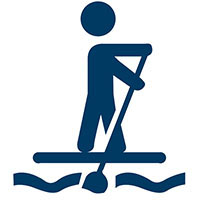Paddle Safe Week is July 21 to 27
— from Washington State Parks —
During Paddle Safe Week, July 21 to 27, the Washington State Parks Boating Program will lead a statewide effort to increase safety awareness among those who kayak, canoe and stand up paddleboard.
Paddlesports continue to grow in popularity, and so do fatal accidents involving paddlers. Since 2012, close to half of all boating fatalities in Washington state involved paddlecraft. Capsizing and swamping are the leading type of accident, and the leading cause of death is drowning. In many cases, victims were not wearing life jackets.

“Many paddlers don’t realize their paddlecraft are actually boats, and the same rules of the road, navigation, and safety apply,” said Rob Sendak, Boating Program manager. “All paddlers are responsible for knowing laws and keeping themselves and others safe. They should seek out some type of formal instruction, whether it’s (from) a certified instructor, a paddling group or an online course.”
“In addition to getting educated, the number-one safety precaution paddlers can take is to wear a lifejacket — always,” Sendak added. “It’s the best way to protect their life in case of an accident.”
Last month, Gov. Jay Inslee signed a proclamation declaring July 21 through July 27 as Paddle Safe Week. During this time, State Parks Boating Program will place additional focus on the following eight safety tips:
- Get educated Knowing about paddling safety leads to a more enjoyable experience. Numerous classes are available through local clubs and outfitters, city and county parks and recreation departments and online.
- Always wear a life jacket State law requires all vessels, including canoes, kayaks and stand up paddleboards, to have at least one properly fitted Coast Guard-approved life jacket for each person on board.
- Carry essential gear Essential safety gear includes a whistle or other sound-producing device (required by law). In addition, people should carry some form of communication device such as a cell phone (in a waterproof bag) or VHF marine radio (while on coastal waters). Other essentials depend on the type of waterway and length of trip and should be researched in advance.
Avoid alcohol and drugs Operating any vessel, including paddlecraft, while under the influence of alcohol, drugs or marijuana, is not only unsafe, it’s illegal.
- Check and understand the weather Paddlers should check the weather frequently before and during their trip, keeping an eye on current conditions and forecasts. Check warnings, weather conditions, wind and wave forecasts, tides and current conditions or river flows— and understand when conditions are beyond their capabilities.
- Protect against cold-water shock Many of Washington’s waters remain below 60 degrees all year — including lakes and rivers — even during hot weather. The biggest risk is not hypothermia; it’s cold-water shock, which occurs in the first stage of immersion. Professionals recommend avoiding cotton and wearing synthetic materials when a wet or dry suit is not available.
- Be visible to other boaters Paddlecraft sit low on the water, so it can be hard for other boaters to see them. The Boating Program advises paddlers to wear bright neon colors and colors that contrast, put highly reflective tape on paddles, use a flagpole and carry a bright light.
- File a float plan Before going out on the water, even for a brief time, people should always tell a trusted friend or relative their plan. Include names of everyone going, the route, what time they’re going and returning, and what to do if they don’t return when expected.
To learn more paddlesport safety tips, visit www.PaddleSafeWa.org.
Follow social media
People can learn more about and participate in Paddle Safe Week through social media by using some of the following hashtags: #PaddleSafeWeek, #PaddleSmart, #PaddleSafe, #PaddleSober, #PaddlePrepared, #PaddleToBeSeen
About the Washington State Boating Program
The Washington State Parks and Recreation Commission administers the state’s Boating Program, which provides leadership in boating safety and environmental education and outreach. The goal of the program is to reduce accidents and fatalities, increase stewardship of Washington waterways, and keep recreational boating a safe, accessible and enjoyable pastime. For more information about the Boating Program, visit www.parks.wa.gov/boating.
**If you are reading theOrcasonian for free, thank your fellow islanders. If you would like to support theOrcasonian CLICK HERE to set your modestly-priced, voluntary subscription. Otherwise, no worries; we’re happy to share with you.**







